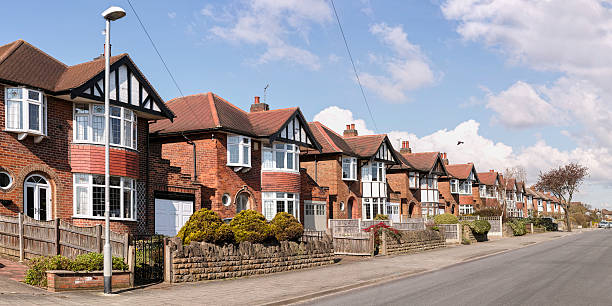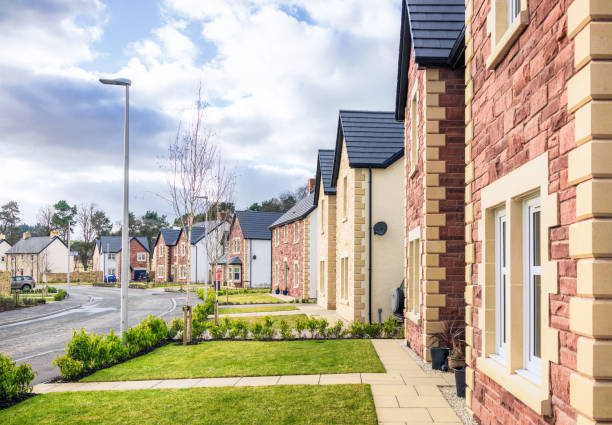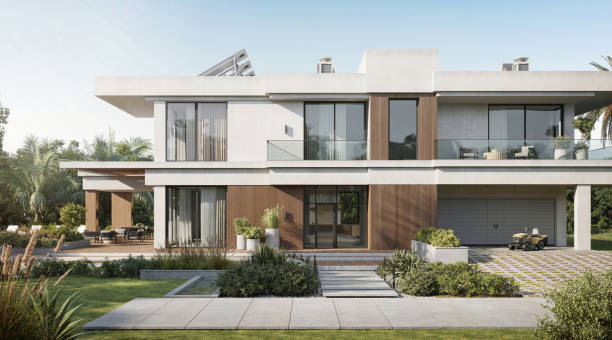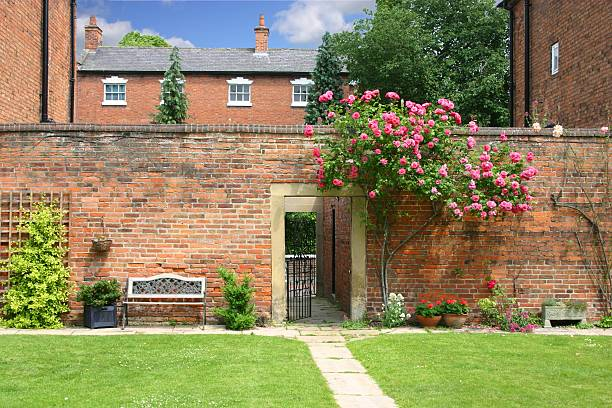In architecture and design, “render” transcends a mere visual representation, encapsulating a structure’s soul. The rendering world is a multifaceted landscape from traditional methods to contemporary digital wonders.
This article embarks on a journey through diverse dimensions, delving into the best types of render that shape our built environment’s visual language. Whether you are an architect seeking inspiration, a house owner looking for the best house rendering options or a design enthusiast curious about the latest trends, join us as we unravel the intricacies of rendering.
Traditional Renders: Unveiling the Timeless Techniques
Cement Render
Unique Features
Cement render, a staple in the various types of rendering techniques, comprises cement, sand, and sometimes lime. Its unique feature lies in its durability and robustness. The cement component provides strength, making it suitable for various climates and surfaces. Additionally, it offers a smooth, matte finish that can be adapted to achieve different textures.
Applications in Construction
Cement-based render finds widespread use in both residential and commercial construction. It is a protective layer for external walls, offering resistance against weather elements such as rain and wind. The sturdiness of traditional cement render makes it an ideal choice for masonry surfaces, providing a visually appealing and long-lasting finish.
Benefits
- Durability: Cement render is renowned for its longevity and ability to withstand harsh weather conditions.
- Versatility: Its versatility allows for different textures and finishes, enhancing aesthetic appeal.
- Fire Resistance: Cement render provides additional fire protection to structures.
- Affordability: Cement rendering is a cost-effective option for people with a tight budget.
Drawbacks:
- Prone to Cracking: In certain conditions, cement render may develop cracks over time, especially if the underlying structure experiences movement.
- Lack of Breathability: Cement render can limit the breathability of walls, potentially leading to moisture retention in some cases.

Lime Render
Unique Features
Lime render, a classic choice with historical significance, is made from lime, sand, and water. Its unique feature lies in its breathability, allowing moisture to escape, which is particularly beneficial for older buildings. Lime render also possesses a natural flexibility, reducing the likelihood of cracks over time.
Applications in Construction
Lime render is commonly used to restore historic buildings due to its compatibility with traditional construction materials like brick and stone. Its breathable nature makes it suitable for structures where moisture management is crucial. Lime render is also favoured for its aesthetic appeal, providing a soft, textured finish.
Benefits
- Breathability: Lime render allows for the passage of moisture, preventing issues related to trapped water.
- Flexibility: Its natural flexibility reduces the likelihood of cracking, especially in buildings with structural movement.
- Historical Authenticity: Lime render is often chosen for restoration projects to maintain the historical authenticity of structures.
Drawbacks
- Requires Skilled Application: Lime render requires skilled application, and improper techniques can lead to issues like poor adhesion.
- Setting Time: Lime render might take more setting time than other renders, requiring patience during application.
Sand and Cement Render
Unique Features
The versatile combination of sand and cement render is crafted from a mix of sand, cement or lime on occasion. Its unique feature lies in its adaptability and strength. The sand component provides texture, while the cement offers durability, making it suitable for various applications.
Applications in Construction
Traditional sand and cement render is commonly used for interior and exterior surfaces. It is ideal for providing a smooth finish to blockwork and brick walls, enhancing their appearance. Its strength and versatility make it a popular choice for modern construction projects.
Benefits
- Versatility: Sand and cement, when mixed with the render coat, can be applied to various surfaces, offering flexibility in design.
- Cost-Effective: It is often more budget-friendly compared to some specialised renders.
- Weather Resistance: The cement component enhances its resistance to weather elements, ensuring durability.
Drawbacks
- Less Breathable: Like cement render, the sand and cement mixture may limit the breathability of walls.
- Potential Cracking: Depending on the mix and application, sand and cement render may be prone to cracking, especially if the substrate experiences movement.

Modern Renders: Unveiling Innovative Trends and Techniques
Acrylic Render Unveiled
Unique Features
Acrylic render is a contemporary rendering solution known for its versatility and durability. Composed of a mixture of acrylic, cement, and other additives, this type of render forms a flexible and breathable coating on surfaces. Its adaptability allows it to be applied to various substrates, including concrete, brick, and lightweight cladding materials. The acrylic content gives the render unique water-resistant and UV-resistant properties, ensuring a long-lasting finish.
Applications in Construction
Acrylic render finds extensive applications in both residential and commercial construction projects. Its flexibility makes it suitable for uneven surfaces and can be applied to exterior walls, facades, and interior walls. The ability to be tinted in a wide range of colours enhances its aesthetic appeal, making it a popular choice for architectural projects with a desired vibrant and durable finish.
Benefits
- Durability: The acrylic render is resistant to cracking and fading, ensuring a long lifespan.
- Weather Resistance: Its water-resistant properties make it ideal for external applications, protecting the elements.
- Versatility: Adaptable to various surfaces and easily tinted, allowing creative design options.
- Ease of Application: Acrylic render is often premixed and can be applied with a trowel or spray machine, reducing installation time.
Drawbacks
- Cost: Acrylic rendering is relatively more expensive than mineral rendering, impacting overall project costs.
- Not Ideal for High-Moisture Areas: While water-resistant, there may be better choices for areas prone to high moisture, such as bathrooms.

Silicone Render
Unique Features
Silicone render is a high-performance modern rendering solution distinguished by its outstanding water-repellent and breathable properties. Comprising silicone resin, cement, and other aggregates, this render creates a hydrophobic surface that repels water, preventing moisture-related issues. Its micro-porous structure allows water vapour to escape, ensuring a dry and healthy substrate.
Applications in Construction
Silicone render is well-suited for exterior applications, offering exceptional protection against harsh weather conditions. It is commonly used on various substrates, including traditional masonry, concrete, and external insulation systems. Its resistance to algae and fungal growth makes it an excellent choice for buildings located in humid climates.
Benefits
- Water Repellency: Silicone render provides superior protection against water ingress, preventing issues such as dampness and mould.
- Breathability: The micro-porous structure allows water vapour to escape, maintaining a dry substrate.
- Low Maintenance: Resistant to algae and fungi, reducing the need for frequent cleaning.
- Colour Retention: Silicone renders often have excellent colour retention properties, maintaining their aesthetic appeal over time.
Drawbacks
- Cost: Similar to acrylic render, silicone render can be more expensive than traditional options.
- Application Complexity: The application may require specialised skills, and it is essential to follow precise mixing and application guidelines for optimal performance.

Monocouche Render
Unique Features
Monocouche Render distinguishes itself with a one-coat application, unlike traditional renders needing multiple layers. This French term, meaning “single layer,” signifies a pre-mixed, through-coloured render, eliminating the need for additional painting. This delivers a seamless finish, ensuring any chips or scratches are less visible, preserving the structure’s aesthetic appeal.
Applications in Construction
Monocouche Render, widely used in diverse construction projects, provides versatility for new builds and renovations. It is ideal for residential, commercial, and architectural applications and offers a modern, low-maintenance exterior finish. Its easy application on various substrates, including brick and concrete, gives architects and builders design flexibility and efficient execution.
Benefits
- Speed of Application: it is a single-coat application, which significantly reduces the time and labour required for rendering projects.
- Colour Consistency: Monocouche render incorporates pigments throughout the mix, ensuring the colour remains consistent across the entire surface.
- Breathability: Monocouche render allows moisture vapour diffusion, promoting breathability in the building envelope.
- Crack Resistance: The formulation of monocouche render includes additives that enhance flexibility, reducing the likelihood of cracking.
Drawbacks
- Skill Requirements: Inexperienced applicators may need help to achieve a uniform finish, potentially compromising the aesthetic appeal.
- Limited Colour Customisation: While monocouche render comes in various pre-mixed colours, the range might not satisfy those seeking highly customised colour options.
- Initial Cost: The upfront cost of monocouche render materials can be higher than traditional renders.

A Critical Decision in Construction:which type of render is the best
When it comes to construction and architectural projects, selecting the right render is a crucial decision that significantly impacts both the aesthetic and structural aspects of a building. Two key considerations in this decision-making process include the factors influencing the decision and sustainability considerations.
Factors Influencing Decision
Several factors come into play when deciding on the most suitable render for a project
Building Type and Purpose
Different types of buildings have varied requirements. For example, residential homes may prioritise a render that enhances curb appeal, while commercial structures may need a more robust, weather-resistant option. Understanding the intended use and purpose of the building is fundamental to choosing an appropriate render.
Climate and Weather Conditions
The local climate plays a pivotal role in determining the durability and longevity of a render. Areas prone to harsh weather conditions, such as extreme heat, cold, or frequent rainfall, require renders that can withstand these challenges. Climate considerations also influence the finish type that best suits the surroundings.
Substrate Material
The substrate, or the material to which the render will be applied, impacts the render choice. Different renders adhere better to specific substrates, and understanding this compatibility is essential for ensuring a lasting and secure application.
Architectural Style and Design Preferences
The architectural style and design vision for a project influence the render’s texture, colour, and finish. Careful consideration of these aesthetic elements is necessary to integrate the render with the overall design seamlessly.
Budget Constraints
Budget considerations play a significant role in the decision-making process. Some renders may be more cost-effective but still meet the project’s requirements, while others may offer premium finishes but at a higher cost. Striking the right balance between quality and budget is critical.

Sustainability Considerations
In the contemporary construction landscape, sustainability is a growing concern. The choice of the best type of new render finish can contribute to a project’s overall environmental impact:
Material Composition
Opting for renders with environmentally friendly compositions can reduce the carbon footprint of a construction project. Natural and recyclable materials and those with lower embodied energy are increasingly popular choices for sustainable construction.
Energy Efficiency
Some renders offer thermal insulation properties, contributing to the energy efficiency of a building. This is particularly relevant in regions with extreme climates, as efficient insulation can lead to reduced heating or cooling costs.
Longevity and Maintenance
Sustainable renders often have longer lifespans and require less maintenance. Choosing a render that doesn’t necessitate frequent repairs or replacements can contribute to the overall sustainability of the structure.
Low VOC Content
Volatile Organic Compounds (VOCs) can adversely affect indoor air quality. Opting for renders with low or zero VOC content promotes healthier indoor environments.
Recyclability and Decomposition
Considering the end-of-life impact of the render is crucial. Renders that are recyclable or decompose naturally contribute to reducing construction waste and its environmental footprint.
Application Techniques: Unlocking the Art of Rendering
Rendering, the final touch that transforms a raw construction into a visually stunning masterpiece, involves skill, precision, and technological innovation. Understanding the application techniques is crucial for achieving the desired finish. In this segment, we explore traditional methods and contemporary application technologies, each contributing to the evolving rendering landscape.
Traditional Methods
Hand Application
Traditional rendering often involves skilled hand tools, where artisans manually apply the render mix onto the surface. This method, rooted in time-honoured practices, requires a keen eye for detail and a steady hand. Hand application allows for a personalised touch, enabling artisans to create unique textures and finishes tailored to the project’s aesthetic requirements.
Float and Set
The float and set method is a traditional technique involving the application of a base coat followed by the use of a float (a flat tool) to achieve a smooth surface. A finishing coat is applied once the base coat is set but still malleable, creating a durable and visually appealing result. This method has been a staple in rendering for its simplicity and effectiveness.
Lime Washing
Lime washing is a traditional rendering technique that involves applying a mixture of lime, water, and pigments onto the surface. This method not only adds colour but also serves as a protective layer. Lime washing is favoured for its breathable nature, allowing moisture to escape and preventing issues like dampness.
Contemporary Application Technologies
Spray Rendering
As technology advances, rendering has embraced spray application techniques. Spray rendering involves using specialised machinery to apply the render mix onto surfaces quickly and evenly. This method is efficient, reducing application time significantly. It is particularly suitable for large projects or areas that require a uniform finish.
Machine Rendering
Machine rendering takes efficiency to the next level, utilising powerful rendering machines that automate the application process. These machines can handle various render mixes and ensure a consistent finish. Machine rendering is favoured for its speed and precision, making it an ideal choice for high-volume projects.
Thin-Coat Rendering
Thin-coat rendering is a contemporary method that involves applying a thin layer of pre-mixed render onto the surface. This technique is known for its versatility and flexibility, allowing for various finishes, including textured, smooth, or even decorative effects. Thin-coat rendering is often preferred for its durability and resistance to cracking.
Acrylic Rendering
Acrylic rendering is a modern application technique that uses acrylic-based render mixes. These mixes, containing acrylic polymers, offer enhanced flexibility, adhesion, and water resistance. Acrylic rendering is famous for its ability to achieve a sleek and contemporary finish, making it a preferred choice in both residential and commercial projects.

Future Trends in Rendering: Innovations in Materials
In the ever-evolving realm of rendering, innovations in materials are shaping the future of architectural finishes. Standard rendering items such as cement and lime have long been the staples, but technological advancements are ushering in a new era. The future promises an array of cutting-edge materials that enhance aesthetics and contribute to sustainability and durability.
Nano Materials
One of the most exciting trends in rendering involves the integration of nanotechnology. Nanomaterials, at the molecular or atomic scale, exhibit unique properties that can significantly enhance the performance of renders. These materials often provide improved resistance to weathering UV radiation and even self-cleaning capabilities, revolutionising the longevity and maintenance of rendered surfaces.
Aerogel-based Renders
Aerogels, known for their exceptional thermal insulating properties, are finding their way into rendering services. Incorporating aerogels into renders can enhance energy efficiency by providing superior insulation. This innovation holds particular promise in sustainable construction, where minimising energy consumption is crucial.
Recycled and Sustainable Aggregates
With a growing emphasis on sustainability, the future of rendering includes a shift towards materials sourced from recycled and sustainable aggregates. Recycled glass, plastics, or industrial by-products are incorporated into renders, reducing environmental impact and promoting a circular economy.
Photocatalytic Renders
Photocatalytic materials are designed to harness sunlight to trigger chemical reactions that break down pollutants. In rendering, photocatalytic materials can contribute to air purification by breaking down organic compounds and contaminants, improving air quality around rendered structures. This innovation aligns with a broader trend towards eco-friendly and health-conscious building practices.

Future Trends in Rendering: Sustainable Practices
As the global focus on sustainability intensifies, rendering practices are transforming to align with eco-friendly principles. Sustainable rendering practices reduce the environmental impact and enhance the resilience and longevity of generated structures. Here are some key trends in sustainable rendering practices shaping the future:
Low Carbon Footprint Materials
Sustainability in rendering involves consciously selecting materials with a low carbon footprint. This includes choosing materials that require less energy in their production or materials made from renewable resources. By opting for low-carbon materials, rendering projects contribute to overall environmental conservation.
Energy-Efficient Application Techniques
The future of rendering incorporates energy-efficient application techniques to minimise resource consumption. Advanced application technologies, such as spray rendering systems and 3D printing, reduce material waste, energy usage, and environmental impact. These techniques also enable faster application, contributing to both sustainability and cost-effectiveness.
Water-Based Renders
Traditional rendering practices often involve solvent-based products, which can have adverse environmental effects. Water-based renders are emerging as a sustainable alternative, reducing volatile organic compound (VOC) emissions and minimising environmental pollution. This trend aligns with a broader movement towards environmentally friendly building materials.
Bio-based Renders
Rendering materials derived from renewable, bio-based sources is gaining popularity in sustainable practices. Bio-based renders often utilise plant-based ingredients, such as hemp or linseed oil, providing a renewable and biodegradable alternative to traditional rendering materials. This shift contributes to reducing reliance on finite resources and promotes ecological balance.
Key Takeaways
- Explores traditional (like Cement, Lime, Sand and Cement) and modern renders (such as Acrylic, Silicone, and Monocouche) with their unique features, applications, benefits, and drawbacks.
- Considers crucial factors like building type, climate, substrate material, design preferences, and budget constraints in choosing the most suitable render for a project.
- Emphasises sustainability aspects in render selection, highlighting material composition, energy efficiency, longevity, low VOC content, recyclability, and decomposition.
Conclusion
As we conclude our exploration into the diverse rendering dimensions, it becomes clear that choosing the right render type from the six different types is a nuanced decision beyond aesthetics. Each render has its unique characteristics, influencing not only the visual appeal of a structure but also its durability and environmental impact. From the timeless charm of traditional renders to the sleek, modern finishes and the seamless beauty of Monocouche Render, architects and builders have various options to elevate their projects. Stay informed, stay inspired, and let your structures tell a story through the art of rendering.



